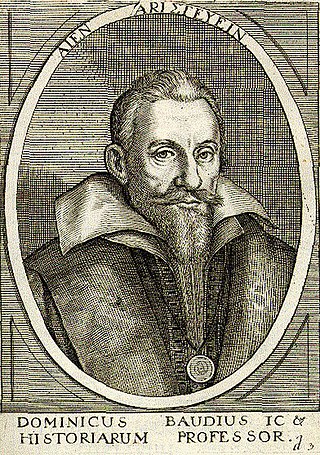This article contains information about the literary events and publications of 1613.
This article contains information about the literary events and publications of 1607.

George Chapman was an English dramatist, translator and poet. He was a classical scholar whose work shows the influence of Stoicism. Chapman has been speculated to be the Rival Poet of Shakespeare's sonnets by William Minto, and as an anticipator of the metaphysical poets of the 17th century. Chapman is best remembered for his translations of Homer's Iliad and Odyssey, and the Homeric Batrachomyomachia.
Michel Baudier, French historian, was born in Languedoc, during the reign of Louis XIII, and was historiographer to the Court of France.

Henry I, Prince of Joinville, Duke of Guise, Count of Eu, sometimes called Le Balafré ('Scarface'), was the eldest son of Francis, Duke of Guise, and Anna d'Este. His maternal grandparents were Ercole II d'Este, Duke of Ferrara, and Renée of France. Through his maternal grandfather, he was a descendant of Lucrezia Borgia and Pope Alexander VI.

The Honourable George Percy was an English explorer, author, and early Colonial Governor of Virginia.
The Tragedy of Bussy D'Ambois (1603–1607) is a Jacobean stage play written by George Chapman. Classified as either a tragedy or "contemporary history," Bussy D'Ambois is widely considered Chapman's greatest play, and is the earliest in a series of plays that Chapman wrote about the French political scene in his era, including the sequel The Revenge of Bussy D'Ambois, the two-part The Conspiracy and Tragedy of Charles, Duke of Byron, and The Tragedy of Chabot, Admiral of France.
The Conspiracy and Tragedy of Charles, Duke of Byron, Marshall of France is a Jacobean tragedy by George Chapman, a two-part play or double play first performed and published in 1608. It tells the story of Charles de Gontaut, duc de Biron, executed for treason in 1602.
The Revenge of Bussy D'Ambois is a Jacobean revenge tragedy written by George Chapman. The Revenge is a sequel to his earlier Bussy D'Ambois, and was first published in 1613.
Caesar and Pompey is a Jacobean era stage play, a classical tragedy written by George Chapman. Arguably Chapman's most obscure play, it is also one of the more problematic works of English Renaissance Drama.
William Aspley was a London publisher of the Elizabethan, Jacobean, and Caroline eras. He was a member of the publishing syndicates that issued the First Folio and Second Folio collections of Shakespeare's plays, in 1623 and 1632.
George Eld was a London printer of the Jacobean era, who produced important works of English Renaissance drama and literature, including key texts by William Shakespeare, Ben Jonson, Christopher Marlowe, and Thomas Middleton.
William Stansby (1572–1638) was a London printer and publisher of the Jacobean and Caroline eras, working under his own name from 1610. One of the most prolific printers of his time, Stansby is best remembered for publishing the landmark first folio collection of the works of Ben Jonson in 1616.

Jacques Specx was a Dutch merchant, who founded the trade on Japan and Korea in 1609. Jacques Specx received the support of William Adams to obtain extensive trading rights from Tokugawa Ieyasu, the shōgun emeritus, on 24 August 1609, which allowed him to establish a trading factory in Hirado on 20 September 1609. He was the interim governor in Batavia between 1629 and 1632. There his daughter Saartje Specx was involved in a scandal. Back home in Holland Specx became an art-collector.
Nationality words link to articles with information on the nation's poetry or literature.

Dominicus Baudius, a latinised form of Dominique Baudier, was a French Neo-Latin poet, scholar and historian. From 1603 to 1613 he was a teacher at the University of Leiden.

Robert Douglas, 1st Viscount of Belhaven PC, was a Scottish courtier.
Dorothea Silking, was a Danish courtier in the household of Anne of Denmark.







